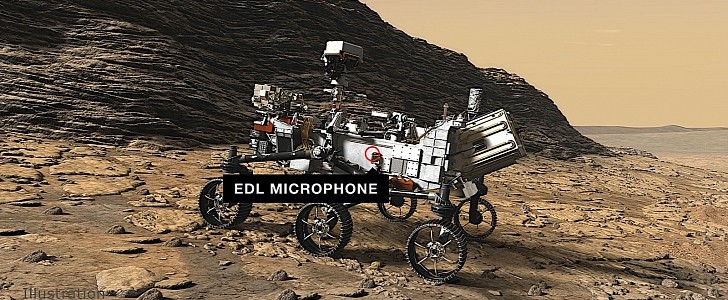The Perseverance rover, the latest NASA hardware to be bagged and tagged for a trip to Mars, is a monument to space exploration firsts. Not only does it pack all the things it needs to conduct never-before-attempted missions on the Red Planet, but it is also capable of hearing stuff in space.
That’s because the machine is equipped with a microphone, a first for Martian exploration hardware, meant to listen for the zaps of an instrument called SuperCam that should be deployed once on Mars. Thanks to it, the machine was however capable of recording something else while still in space.
According to NASA, what you are about to hear was recorded in October (due to the distance of the rover and Mars from Earth, we should get used to such delays) “during an in-flight checkout of the camera and microphone system that will pick up some of the landing drama at Mars' Jezero Crater early next year.”
The high-pitched squeal you’re hearing is apparently not from some alien spaceship chasing Perseverance through the darkness of space, nor is it the sound made by some mysterious interplanetary creature.
Instead, we’re apparently listening to both the spaceship itself, but also the rover’s own heat rejection fluid pump, a piece of hardware meant to help maintain operational temperatures for vehicle components.
"With apologies to the person who came up with the slogan for 'Alien,' I guess you could say that in space no one may be able to hear you scream, but they can hear your heat rejection fluid pump," said in a statement Dave Gruel, lead engineer for Mars 2020's EDL Camera and Microphone subsystem.
"The microphone we included to hear what it's like to land on Mars was actually able to pick up Perseverance's thermal system operating in the vacuum of space through mechanical vibration."
And if you were wondering how hearing stuff in space is possible, given how it's a void and sound doesn’t like to move through that, the agency has an explanation for this, too. Sound waves can travel through solid objects, get picked up by an electrical component, and sometimes are turned into an electrical signal. Then some processors get involved, and voila, the sound of the rover in space.
According to NASA, what you are about to hear was recorded in October (due to the distance of the rover and Mars from Earth, we should get used to such delays) “during an in-flight checkout of the camera and microphone system that will pick up some of the landing drama at Mars' Jezero Crater early next year.”
The high-pitched squeal you’re hearing is apparently not from some alien spaceship chasing Perseverance through the darkness of space, nor is it the sound made by some mysterious interplanetary creature.
Instead, we’re apparently listening to both the spaceship itself, but also the rover’s own heat rejection fluid pump, a piece of hardware meant to help maintain operational temperatures for vehicle components.
"With apologies to the person who came up with the slogan for 'Alien,' I guess you could say that in space no one may be able to hear you scream, but they can hear your heat rejection fluid pump," said in a statement Dave Gruel, lead engineer for Mars 2020's EDL Camera and Microphone subsystem.
"The microphone we included to hear what it's like to land on Mars was actually able to pick up Perseverance's thermal system operating in the vacuum of space through mechanical vibration."
And if you were wondering how hearing stuff in space is possible, given how it's a void and sound doesn’t like to move through that, the agency has an explanation for this, too. Sound waves can travel through solid objects, get picked up by an electrical component, and sometimes are turned into an electrical signal. Then some processors get involved, and voila, the sound of the rover in space.

